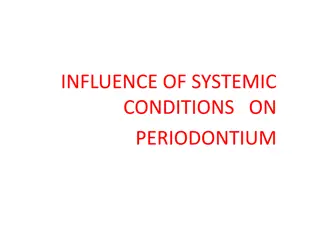Understanding Puberty: Physiology, Changes, and Management
Puberty is a normal physiological process marking the transition from childhood to sexual maturity. Understanding its physiology, factors influencing it, physical changes, stages of development, onset, and precocious puberty is essential for proper diagnosis and management. Various factors like race, heredity, body weight, exercise, and psychological factors influence puberty onset. Physical changes include thelarche, growth spurt, pubarche, menarche, and adrenarche. Stages of development are classified by Marshal & Tanner into five stages. Precocious puberty is defined as early onset before 8 years in girls and 9 years in boys, classified as central or peripheral.
Download Presentation

Please find below an Image/Link to download the presentation.
The content on the website is provided AS IS for your information and personal use only. It may not be sold, licensed, or shared on other websites without obtaining consent from the author. Download presentation by click this link. If you encounter any issues during the download, it is possible that the publisher has removed the file from their server.
E N D
Presentation Transcript
Puberty Dr . Wassan nori C.A.B.O.G.
Objective To define puberty To understand the physiology of puberty To know the normal sequence of puberty To understand the somatic changes associated with puberty To diagnose abnormal puberty ( history , examination and investigations) To treat precocious puberty.
Definition: Normal physiologic transition from childhood to sexual and reproductive maturity. This leads to complex development of secondary sexual characteristics Involving the breast ,sexual hair and genitalia in addition to limited acceleration in body growth
Physiology of puberty : During childhood, the Hypothalamic Pituitary Ovarian ( HPO )axis is suppressed and levels of GnRH, FSH and LH are very low. From the age of 8 9 years GnRH is secreted in pulsations of increasing amplitude and frequency
puberty influenced by many factors including Race. Heredity. Body weight . Exercise. Leptin plays a permissive role in the onset of puberty. Nutritional status . Psychological factors .
Physical(somatic) changes of puberty In sequence of appearance : Thelarche The growth spurt Pubarche Menarche Adrenarche
Marshal & Tanner classify the stages of development into five stages: Stage1 Stage 2 Stage3 Stage 4 Stage 5
When pubery start? Initial pubertal changes occur between 8 and 13 years
Precocious puberty Defined as the onset of puberty before the age of 8 years in a girl or 9 years in a boy. It is classified : Central precocious puberty Peripheral precocious puberty:
Heterosexual and Isosexual: Isosexual precocious puberty: characteristics ( premature sexual maturation like premature thelarche ). Heterosexual (contrasexual ) precocious puberty : In this type patients may develop secondary sexual characteristics in opposite direction
Causes of Heterosexual p p . It is most commonly caused by increased androgen secretion from the adrenal gland or the ovary , causes include : 1*congenital adrenal hyperplasia. 2*androgen secreting tumor from adrenal gland or ovary . 3*cushing syndrome 4*exposure to exogenous androgen . Treatment :is directed at correction of the underlying etiology .
Causes of precocious puberty : * idiopathic *ovarian *organic brain disease *adrenal *exogenous estrogen or androgen exposure .
Complications of precocious puberty : short stature due to premature closure of the epiphyseal plate as a result of sex steroids. psychological abnormalities like depression and schizophrenia .
managment: Meticulous history and examination to detect any possible cause Investigations 1. serial bone age( wrist Xray is done) 2. magnetic resonance imaging (MRI) or computed tomography (CT) of the brain. 3. MRI , CT ,or ultrasonography of abdomen , pelvis or adrenal gland .
investigation 4. assay of serum levels of FSH ,LH which are high in centrally mediated precocious puberty and low in ovarian tumours . 5.laparoscopy may be required for abdominal or pelvic tumours .
Treatment : Treatment goals focus on preventing reduced final adult height and limiting the psychological effects of early pubertal development. Epiphyseal fusion is an estrogen-dependent process. 1. In centrally mediated precocious puberty after exclusion of intracranial tumours , the use of GnRH analogues to suppress the pituitary gland is justified until the age of 11.5 - 12 years when the natural onset of puberty occurs . 2. Treatment of ovarian or adrenal tumours. 3 .Psychological support .
Delayed puberty : Puberty is considered delayed if no secondary sexual characteristics are noted by age 13 or if menses are still absent by age 16 .It affect 3 percent of aldoscents .
Causes of delayed puberty : 1.constitutional delay is the most common 2.Chronic anovulation (polycystic ovarian syndrome ). 3. Anatomic. 4. Androgen insensitivity syndrome . 5. Hypergonadotrophic hypogonadsim 6.Hypogonadotrophic hypogonadisim
Constitutional delay is the most common, it is a normal variation which is usually self correcting.. These adolescents present with lack of both secondary sexual characteristics and pubertal growth spurt by age 13 years. The probable cause is a delay in the reactivation of the GnRH pulse generator .
Patients may be started on low-dose estrogen until puberty progresses, at which point estrogen may be discontinued. During low-dose estrogen treatment, it is not necessary to introduce progesterone withdrawal because in early puberty there is a similarly long period of unopposed estrogen prior to ovulatory cycles
Summary Puberty : Normal physiologic transition from childhood to sexual and reproductive maturity. Initial pubertal changes occur between 8 and 13 years Precocious puberty Delay puberty























